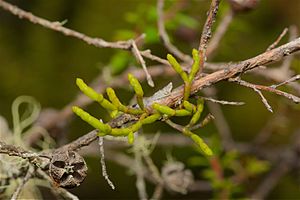Korthalsella salicornioides facts for kids
Quick facts for kids Korthalsella salicornioides |
|
|---|---|
 |
|
| Korthalsella salicornioides on manuka | |
| Scientific classification | |
| Genus: |
Korthalsella
|
| Species: |
salicornioides
|
Korthalsella salicornioides, also known as dwarf mistletoe, is a special plant found only in New Zealand. It is a parasitic plant, meaning it grows on other plants to get its food.
About Dwarf Mistletoe
This plant gets its name from another plant called Salicornia. This is because Korthalsella salicornioides has thick, fleshy stems, much like Salicornia. These stems look like a thick bunch of small, juicy twigs.
The twigs can grow up to 10 centimeters (about 4 inches) long. They do not have leaves. This dwarf mistletoe usually grows on two common New Zealand trees: manuka (Leptospermum scoparium) and kanuka (Kunzea ericoides).
Appearance and Life Cycle
The plant can be reddish-yellow or green. It has very tiny flowers. From October to May, it grows small, yellow fruits.
There are two other types of leafless mistletoe in New Zealand that are part of the Korthalsella family. Korthalsella salicornioides looks similar to them. However, its stems grow closer together and at a sharper angle.
Protecting This Plant
You can find Korthalsella salicornioides scattered throughout forests and scrublands in New Zealand. It is only found in large numbers in a few small areas.
Why It Needs Help
In some places, this plant is at risk. People sometimes cut down its host trees, manuka and kanuka. This happens when trees are used for firewood, cleared for farming, or replaced with other types of trees.
The Department of Conservation has listed Korthalsella salicornioides as "At Risk: Naturally Uncommon." This means it is not found everywhere and needs protection to keep its populations healthy.

